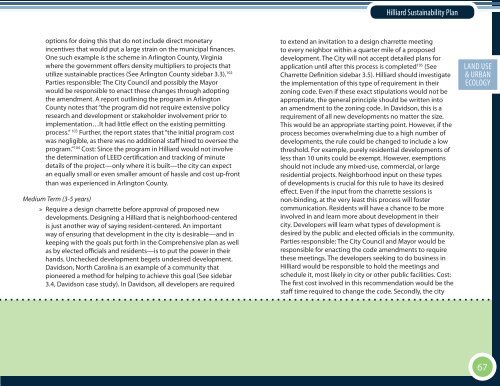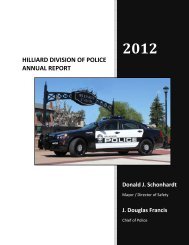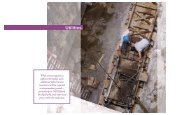The City of Hilliard Sustainability Plan
The City of Hilliard Sustainability Plan
The City of Hilliard Sustainability Plan
You also want an ePaper? Increase the reach of your titles
YUMPU automatically turns print PDFs into web optimized ePapers that Google loves.
<strong>Hilliard</strong> <strong>Sustainability</strong> <strong>Plan</strong>options for doing this that do not include direct monetaryincentives that would put a large strain on the municipal finances.One such example is the scheme in Arlington County, Virginiawhere the government <strong>of</strong>fers density multipliers to projects thatutilize sustainable practices (See Arlington County sidebar 3.3). 102Parties responsible: <strong>The</strong> <strong>City</strong> Council and possibly the Mayorwould be responsible to enact these changes through adoptingthe amendment. A report outlining the program in ArlingtonCounty notes that “the program did not require extensive policyresearch and development or stakeholder involvement prior toimplementation…It had little effect on the existing permittingprocess.” 103 Further, the report states that “the initial program costwas negligible, as there was no additional staff hired to oversee theprogram.” 104 Cost: Since the program in <strong>Hilliard</strong> would not involvethe determination <strong>of</strong> LEED certification and tracking <strong>of</strong> minutedetails <strong>of</strong> the project—only where it is built—the city can expectan equally small or even smaller amount <strong>of</strong> hassle and cost up-frontthan was experienced in Arlington County.Medium Term (3-5 years)» Require a design charrette before approval <strong>of</strong> proposed newdevelopments. Designing a <strong>Hilliard</strong> that is neighborhood-centeredis just another way <strong>of</strong> saying resident-centered. An importantway <strong>of</strong> ensuring that development in the city is desirable—and inkeeping with the goals put forth in the Comprehensive plan as wellas by elected <strong>of</strong>ficials and residents—is to put the power in theirhands. Unchecked development begets undesired development.Davidson, North Carolina is an example <strong>of</strong> a community thatpioneered a method for helping to achieve this goal (See sidebar3.4, Davidson case study). In Davidson, all developers are requiredto extend an invitation to a design charrette meetingto every neighbor within a quarter mile <strong>of</strong> a proposeddevelopment. <strong>The</strong> <strong>City</strong> will not accept detailed plans forapplication until after this process is completed 105 (SeeCharrette Definition sidebar 3.5). <strong>Hilliard</strong> should investigatethe implementation <strong>of</strong> this type <strong>of</strong> requirement in theirzoning code. Even if these exact stipulations would not beappropriate, the general principle should be written intoan amendment to the zoning code. In Davidson, this is arequirement <strong>of</strong> all new developments no matter the size.This would be an appropriate starting point. However, if theprocess becomes overwhelming due to a high number <strong>of</strong>developments, the rule could be changed to include a lowthreshold. For example, purely residential developments <strong>of</strong>less than 10 units could be exempt. However, exemptionsshould not include any mixed-use, commercial, or largeresidential projects. Neighborhood input on these types<strong>of</strong> developments is crucial for this rule to have its desiredeffect. Even if the input from the charrette sessions isnon-binding, at the very least this process will fostercommunication. Residents will have a chance to be moreinvolved in and learn more about development in theircity. Developers will learn what types <strong>of</strong> development isdesired by the public and elected <strong>of</strong>ficials in the community.Parties responsible: <strong>The</strong> <strong>City</strong> Council and Mayor would beresponsible for enacting the code amendments to requirethese meetings. <strong>The</strong> developers seeking to do business in<strong>Hilliard</strong> would be responsible to hold the meetings andschedule it, most likely in city or other public facilities. Cost:<strong>The</strong> first cost involved in this recommendation would be thestaff time required to change the code. Secondly, the cityECON. EXECUTIVELAND DEV. USESOCIAL SUMMARY& URBAN EQ.ECOLOGY67






